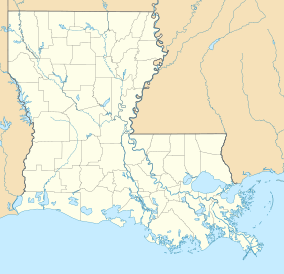White Lake Wetlands Conservation Area facts for kids
Quick facts for kids White Lake Wetlands Conservation Area |
|
|---|---|
| Location | Vermilion Parish, Louisiana, United States |
| Area | 71,905 acres (290.99 km2) |
| Named for | White Lake |
| Governing body | Louisiana Department of Wildlife and Fisheries |
The White Lake Wetlands Conservation Area (WLWCA) is a huge protected natural area in Louisiana. It covers about 71,905 acres, which is like 54,000 football fields! This special place is found in Vermilion Parish, about 7 miles south of a town called Gueydan. It's officially known as the White Lake Property.
Contents
About the Area
This conservation area is located along the northern edge of White Lake. It's a very diverse place with many different kinds of natural homes for plants and animals. The Louisiana Department of Wildlife and Fisheries (LDWF) manages this area.
Most of the area, about 53,249 acres, is a freshwater marsh. A marsh is a type of wetland with grassy plants growing in shallow water. The rest of the land, about 18,656 acres, includes farms, more wetlands, wooded spots, and even places for camping. There are many waterways here, like canals and smaller lakes, such as Lake Le Bleu.
How it Became a Protected Area
The White Lake Wetlands Conservation Area became a protected area thanks to a big donation. On July 8, 2002, a company called British Petroleum (BP) gave this large piece of land to the State of Louisiana.
At first, a group called White Lake Preservation Inc. helped manage it. Then, on January 1, 2005, the Louisiana Department of Wildlife and Fisheries (LDWF) took over control. Before BP, other companies and people owned parts of this land, but BP decided to make it a conservation area.
Plants of White Lake
The White Lake Conservation Area is full of different kinds of plants, also known as flora. These plants are important for the animals that live there. Some of the common plants you might see include:
- Maidencane
- Bull Tongue
- Cattail
- Jamaican Sawgrass (Cladium jamaicense)
- Roseau Cane
- Spikerush
- Walter's Millet (Echinochloa walteri)
- Buttonbush
Animals of White Lake
This area is home to many different animals, known as fauna. You can find deer, alligators, doves, and squirrels. It's also a very important place for many kinds of birds, especially waterfowl. These include ducks, Black-crowned night herons, and the famous Whooping cranes.
Whooping Crane Life Cycle
The Whooping crane is a very special bird. It's one of the tallest birds in North America. Sadly, these cranes almost disappeared from Louisiana by the 1950s. This is called being extirpated.
To help bring them back, several groups worked together starting in 2011. These groups include the U.S. Fish and Wildlife Service, the Canadian Wildlife Service, and the International Crane Foundation. They worked with the LDWF to bring non-migratory Whooping cranes back to Louisiana.
These new cranes come from special breeding centers. Some are from the Patuxent Wildlife Research Center in Maryland. Others come from the International Crane Foundation in Wisconsin and the Calgary Zoo in Alberta, Canada. The White Lake Wetlands Conservation Area and the Rockefeller Wildlife Refuge were chosen as safe places to release these cranes.
By 2014, 40 Whooping cranes were living in Louisiana. This was thanks to 14 new cranes released that year. In 2016, two new Whooping crane chicks even hatched in the wild in Jefferson Davis Parish. This was a big step in helping their population grow!
Bird Watching and Nature Photography
If you love birds, this is a great place to visit! There's a two-mile trail perfect for birdwatching and enjoying nature. It has an elevated observation deck, which is like a tall platform. From here, you can get a great view of the area.
This spot is perfect for nature photography and educational trips. People have seen about 300 different kinds of birds here. Over 174 of these species have been officially recorded. It's a wonderful opportunity to see many beautiful birds in their natural home.


